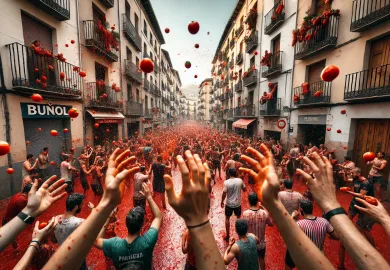
Japan is a country deeply rooted in tradition, and one of its most beautiful and celebrated customs is Hanami, the art of enjoying the fleeting beauty of cherry blossoms. Every spring, the entire nation comes alive with vibrant hues of pink and white as cherry trees, or sakura, bloom across the country. Hanami is not just a simple viewing of flowers; it is a celebration of life, the passage of time, and the joy of being surrounded by nature’s ephemeral beauty. This article will delve into the history, significance, and cultural practices surrounding Hanami in Japan, offering a comprehensive guide to understanding this timeless tradition.
The Historical Roots of Hanami
Hanami, which literally means “flower viewing,” has its origins in ancient Japan, dating back over a thousand years. The tradition is believed to have started during the Nara period (710–794) when the Japanese aristocracy would gather to admire the blossoming cherry trees and write poetry inspired by their beauty. However, it was during the Heian period (794–1185) that Hanami became more widespread, especially among the imperial court in Kyoto.
Cherry blossoms were seen as a metaphor for the fleeting nature of life, an idea deeply ingrained in Buddhist philosophy. The delicate flowers bloom for only a short period, reminding people of the transient nature of beauty and existence. Over time, Hanami spread beyond the elite circles and became a popular activity among all classes of Japanese society.
The practice of Hanami was further popularized during the Edo period (1603–1868) when shogun Tokugawa Yoshimune ordered the planting of cherry trees in various locations around Edo (now Tokyo). This made it easier for the general public to participate in Hanami, solidifying it as a beloved national pastime.
The Symbolism of Cherry Blossoms in Japanese Culture
Cherry blossoms, or sakura, hold a special place in Japanese culture. Their delicate beauty and brief blooming period have made them a symbol of the impermanence of life. This concept, known as “mono no aware,” is a central theme in Japanese aesthetics and literature. The idea reflects a deep appreciation for the fleeting moments of beauty and the inevitability of change.
Sakura are often associated with new beginnings, as their bloom coincides with the start of the school year and the fiscal year in Japan. The sight of cherry blossoms heralds the arrival of spring, a time of renewal and hope. This connection to new beginnings is also why cherry blossoms are frequently featured in Japanese art, poetry, and ceremonies.
The blossoms are also a symbol of national pride, representing the spirit of Japan. During World War II, cherry blossoms were used as a symbol of sacrifice and were often painted on the sides of kamikaze planes. Today, while the militaristic associations have faded, the cherry blossom remains a potent symbol of Japan’s cultural identity.
How to Experience Hanami Like a Local
To truly appreciate Hanami, one must experience it like the Japanese do. Hanami is not just about admiring the flowers from afar; it is a social event that involves picnicking under the blooming trees with friends and family. Parks and public spaces across Japan become lively gathering spots where people spread out blankets, share food and drinks, and enjoy the company of loved ones amidst the stunning backdrop of sakura.
One of the most important aspects of Hanami is the food. Traditional Japanese dishes such as bento boxes, sushi, tempura, and seasonal snacks like sakura mochi (sweet rice cakes wrapped in cherry blossom leaves) are commonly enjoyed during Hanami. Drinks, especially sake and beer, are also a central part of the celebration, with many toasting to the beauty of the blossoms and the joy of the season.
To experience Hanami like a local, it’s essential to plan ahead. Popular Hanami spots, such as Ueno Park in Tokyo or Maruyama Park in Kyoto, can get very crowded, so arriving early to secure a good spot is crucial. Many people even reserve their spots by laying out blankets in the early morning or the night before. It’s also important to be mindful of Hanami etiquette, such as not picking the blossoms and cleaning up after your picnic.
The Best Places to Enjoy Hanami in Japan
Japan is blessed with countless beautiful locations to enjoy Hanami, each offering its unique charm and atmosphere. Here are some of the most iconic spots to experience the magic of cherry blossoms:
- Ueno Park, Tokyo: Ueno Park is one of Tokyo’s most popular Hanami spots, attracting thousands of visitors every year. The park is home to over 1,000 cherry trees that line the main pathway, creating a stunning tunnel of blossoms. The lively atmosphere, combined with the park’s proximity to cultural attractions such as museums and temples, makes it a must-visit during the Hanami season.
- Maruyama Park, Kyoto: Maruyama Park, located near the famous Yasaka Shrine in Kyoto, is another popular Hanami destination. The park’s centerpiece is a large weeping cherry tree, which is illuminated at night, creating a magical ambiance. The surrounding area is also home to traditional teahouses and restaurants, offering a perfect blend of nature and culture.
- Mount Yoshino, Nara: For a more serene Hanami experience, Mount Yoshino in Nara Prefecture is the place to be. The mountain is covered with over 30,000 cherry trees, making it one of the most famous cherry blossom viewing spots in Japan. The blossoms here are staggered across different elevations, allowing for a prolonged Hanami season as the trees at higher altitudes bloom later.
Each of these locations offers a unique Hanami experience, from the bustling city parks to the tranquil mountain landscapes, showcasing the diversity and beauty of Japan’s cherry blossom season.
Hanami Beyond Cherry Blossoms: Other Flower Festivals in Japan
While cherry blossoms are undoubtedly the star of the show during spring, Japan is home to a variety of other flower festivals that are equally captivating. These festivals celebrate different types of flowers and offer a different perspective on Japan’s natural beauty.
- Wisteria at Ashikaga Flower Park: Located in Tochigi Prefecture, Ashikaga Flower Park is famous for its breathtaking wisteria displays. The park’s 150-year-old wisteria trees create stunning tunnels of cascading purple, white, and pink flowers. The annual wisteria festival, held from mid-April to mid-May, attracts visitors from around the world.
- Nemophila at Hitachi Seaside Park: In Ibaraki Prefecture, Hitachi Seaside Park is known for its vast fields of nemophila, or baby blue eyes. During late April to early May, the park’s hills are covered in a sea of blue flowers, creating a surreal and mesmerizing landscape. The contrast between the blue flowers and the blue sky is truly a sight to behold.
- Shibazakura at Fuji Five Lakes: The Shibazakura Festival, held near the Fuji Five Lakes in Yamanashi Prefecture, is another must-see event. Shibazakura, or moss phlox, are small pink, white, and purple flowers that create a vibrant carpet at the base of Mount Fuji. The festival offers stunning views of the flowers with the iconic mountain in the background, making it a photographer’s paradise.
These flower festivals highlight the diversity of Japan’s flora and offer additional opportunities to enjoy the country’s natural beauty beyond the cherry blossom season.
Conclusion
Hanami in Japan is more than just a tradition; it is a celebration of life, beauty, and the fleeting nature of existence. The cherry blossoms, with their brief but brilliant bloom, remind us to cherish the present moment and find joy in the simple pleasures of life. Whether you are picnicking under the sakura in a bustling city park or enjoying the serene beauty of cherry blossoms on a mountainside, Hanami is an experience that captures the essence of Japanese culture.
As you plan your next visit to Japan, make sure to immerse yourself in the magic of Hanami and explore the many other flower festivals that the country has to offer. Each bloom, whether it be cherry blossoms, wisteria, or nemophila, brings its own unique charm and beauty, offering a glimpse into Japan’s deep appreciation for nature and the changing seasons.
Embrace the beauty of Hanami, and you will discover a tradition that has captivated the hearts of the Japanese people for centuries—a timeless celebration that continues to inspire awe and wonder in all who experience it.








